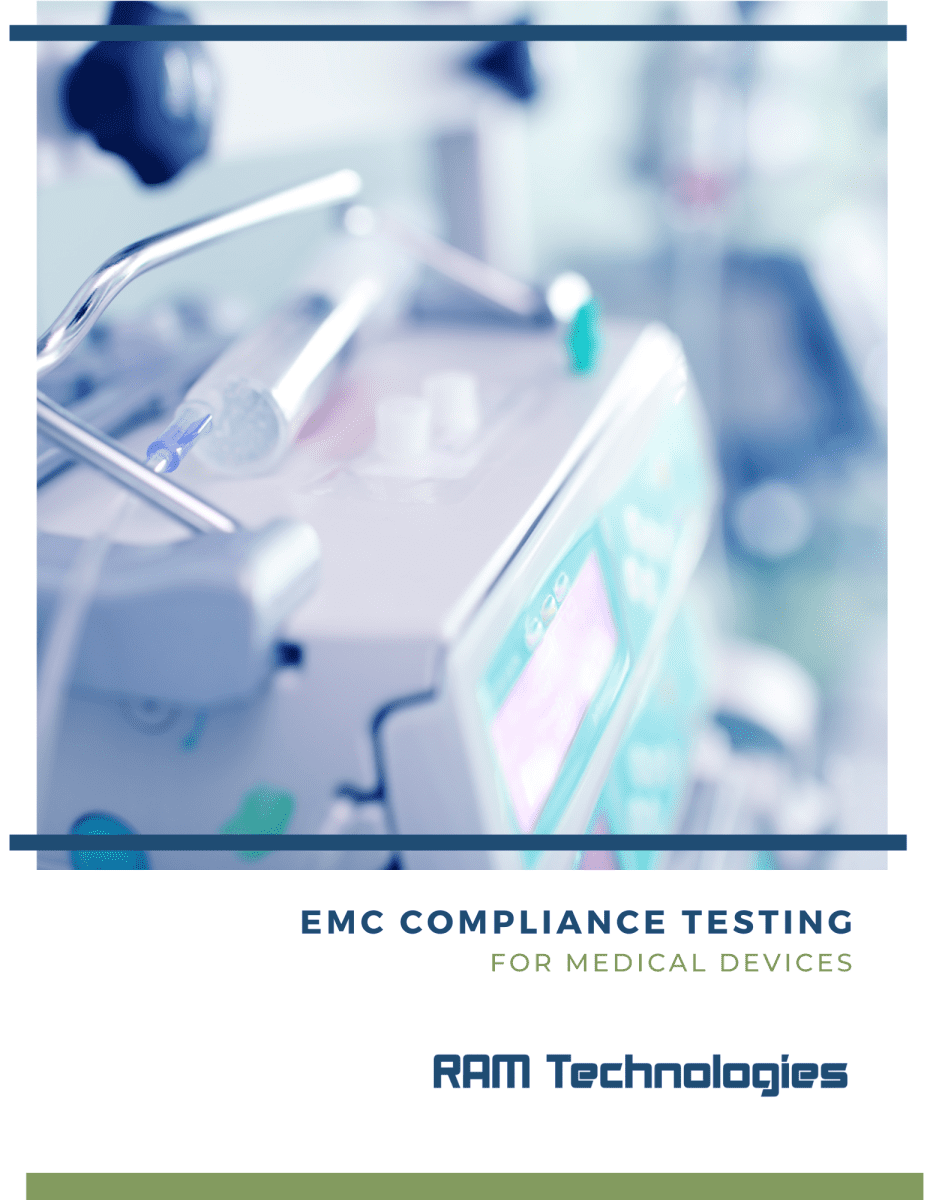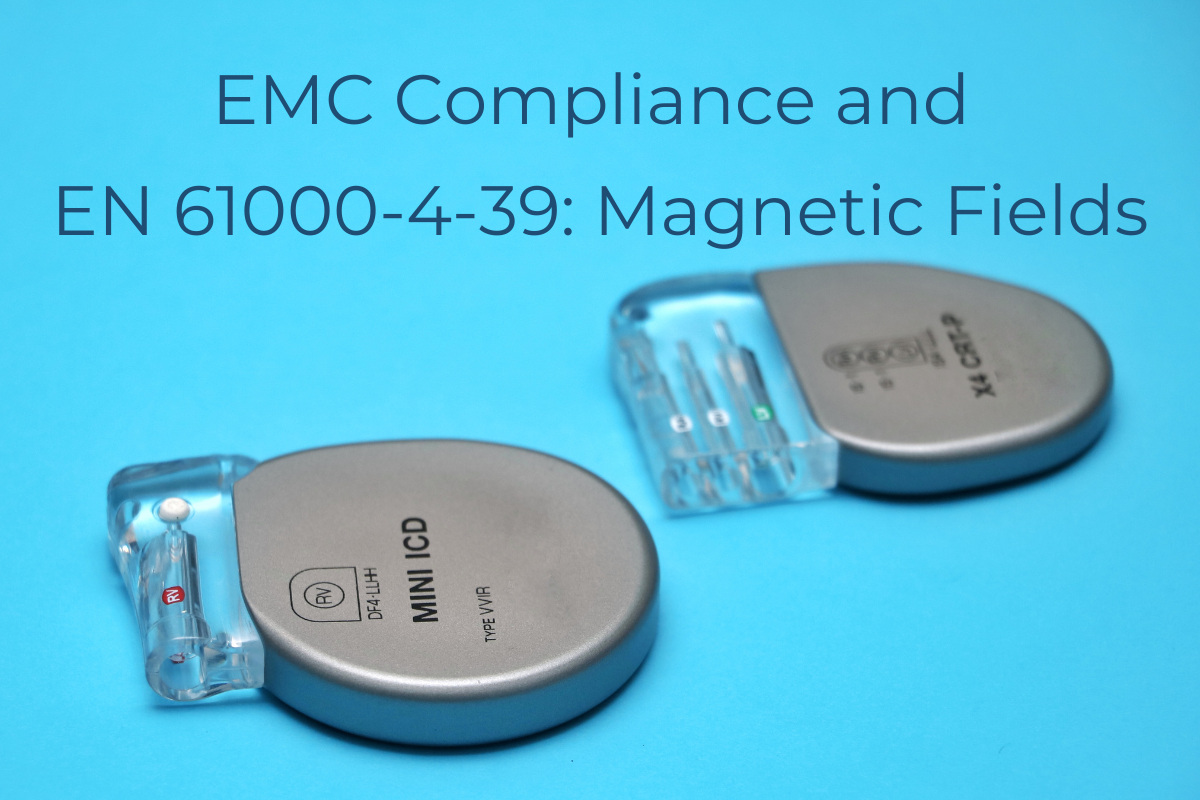EMC Compliance and EN 61000-4-39: What Manufacturers Should Know About RF Radiated Near-Field Disturbances
An important step in the journey to bringing your medical device to market is ensuring that it meets all necessary electromagnetic compatibility (EMC) standards.
One standard that’s important for many medical devices is EN 61000-4-39, which tests how well your medical device can handle electromagnetic interference (EMI) from close-up radio frequency (RF) sources, including cell phones and wireless headphones. Passing these tests means your device is verified to work properly even in a crowded environment, which is key for ensuring patient safety.
We’ll cover what EN 61000-4-39 is, why it’s important, and some basics on testing.
What is EN 61000-4-39?
EN 61000-4-39, also known as IEC 61000-4-39, is a standard that can ensure electronic and electrical equipment will withstand electromagnetic interference (EMI) coming from nearby radio frequency (RF) transmitters. Frequencies from 9 kHz to 6 GHz are covered by this standard.
While this may sound similar to EN 61000-4-3 and EN 61000-4-6, each standard covers different frequency ranges, applies to different coupling methods, and has different applications
- EN 61000-4-3: Applies to frequency range 2 MHz to 80 MHz, radiated coupling methods, and far-field applications
- EN 61000-4-6: Applies to frequency range 150 kHz to 80 MHz, conducted coupling methods, and conducted applications
- EN 61000-4-39: Applies to frequency range 9 kHz to 6 GHz, radiated coupling methods, and near-field applications
There are other EMC standards that also test for radiated immunity. EN 61000-4-20 is about EMC testing in transverse electromagnetic (TEM) waveguides, EN 61000-4-21 is about reverberation chamber methods, and EN 61000-4-22 is about testing in fully anechoic rooms, or FARs – echo-free chambers.
The guidelines in IEC 61000-4-39 shouldn’t be seen as a replacement for general immunity requirements as outlined in IEC 61000-4-3 or other parts of the EN/IEC 61000 standards.
Close proximity is defined by how far the source is from the equipment. For frequencies less than 26 MHz, close proximity means less than or equal to 500mm. For frequencies greater than 26 MHz, close proximity would be less than or equal to 200m.
Why is EN 61000-4-39 important?
Radiofrequency (RF) transmitters are becoming more common, and EN 61000-4-39 sets the standard to protect electronic equipment from electromagnetic interference (EMI) caused by RF transmitters. These emissions can interfere with how electronic equipment operates, so it’s important to ensure that equipment is immune to EMI from these sources, especially when used to perform critical tasks.
Abiding by EN 61000-4-39 also helps protect operators and consumers from harm. EMI can lead to malfunctions that endanger the safety of those on both sides of the equipment.
What devices are applicable under IEC 61000-4-39?
Equipment in the following categories is subject to EN 61000-4-39:
- Fixed-installation equipment that is exposed to portable transmitting devices
- Mobile equipment that is exposed to fixed-installed transmitting devices
- Mobile equipment that is exposed to other mobile transmitting devices
The electromagnetic disturbances measured by this standard are focused on continuous narrow-band signals. It is not focused on transient or impulsive signals. These are better covered in other standards.
Testing for IEC 61000-4-39
Depending on the RF field type and frequency being tested on the equipment, different antennas will be used to create an RF field.
To test magnetic field immunity between 9kHz and 150kHz, a loop antenna will be used. This antenna should have a 120mm diameter (±10 mm) and 20 turns. A standard antenna used for this is the MIL-STD-461G:2015 (test RS101) antenna. Turns denote how many times the wire of a loop antenna is wrapped around a core.
Testing magnetic field immunity between 150kHz and 25MHz can be done with a loop antenna that has a 100mm diameter (±10mm) with 3 turns.
For RF fields between 380MHz and 6 GHz, a TEM (transverse electromagnetic) horn antenna can be used.
The testing setup will look different if the equipment under test (EUT) normally stands on the floor versus if it is wall-mounted, portable, or a tabletop device. For example, for devices that aren’t floor-standing, the standard outlines placement on a support with a height of 0.80m (±0.05m).
For all surfaces of the EUT subject to illumination by magnetic fields during normal operating conditions, different windows should be partitioned for testing:
- 100mm x 100mm windows should be used for magnetic field immunity from 9kHz to 150kHz.
- 80mm x 80mm windows should be used for magnetic field immunity from 150kHz to 25MHz.
- 300mm x 300mm windows should be used for RF fields from 380MHz to 6GHz.
Test Levels for EN 61000-4-39
When testing frequencies or frequency bands, testers should focus on the frequencies where intentional RF-emitting devices are actually operating. To achieve this, the standard outlines a few test levels for close proximity magnetic field immunity in two different ranges: 9kHz to 150kHz and 150kHz to 26MHz. Test levels are also defined for close proximity RF immunity between 380MHz and 6GHz.
More details on testing can be found through IEC or on the Academy of EMC website.
What to know about EMC Compliance and PSUSs for Your Medical Device
RAM Technologies power supplies are not directly tested against specific EMC standards. However, they are designed and manufactured to comply with all applicable standards. This means that integrating our PSUs into your devices will not affect your compliance with relevant EMC requirements. If you have any questions regarding the EMC compliance of our PSUs, please feel free to contact us. You can also find more information on our downloadable data sheets, which are available on each power supply page.
RAM Technologies’ power supplies are 60601-1 3.2 certified and meet 60601-1-2 EMC standards. When you’re designing your medical device and need help with a PSU, contact us for details.

Download the EMC Summary
The road to putting your medical device on the market includes many steps, including passing all necessary electromagnetic compatibility (EMC) testing. These tests play an essential role in ensuring your device doesn’t emit a significant amount of electromagnetic interference, which could be via conducted or radiated emissions. Download our guide to EMC compliance to learn more about what medical device manufacturers should consider.
More Resources:
Downloadable Guide to IEC 60601-1
EMC Compliance and EN 61000-4-6: Conducted Immunity
EMC Compliance and EN61000-4-11: Voltage Dips, Short Interruptions
EMC Compliance and EN 61000-4-5: Surge
